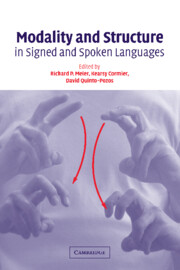Book contents
- Frontmatter
- Contents
- List of figures
- List of tables
- List of contributors
- Acknowledgements
- 1 Why different, why the same? Explaining effects and non-effects of modality upon linguistic structure in sign and speech
- Part I Phonological structure in signed languages
- Part II Gesture and iconicity in sign and speech
- Part III Syntax in sign: Few or no effects of modality
- Part IV Using space and describing space: Pronouns, classifiers, and verb agreement
- Index
- References
1 - Why different, why the same? Explaining effects and non-effects of modality upon linguistic structure in sign and speech
Published online by Cambridge University Press: 22 September 2009
- Frontmatter
- Contents
- List of figures
- List of tables
- List of contributors
- Acknowledgements
- 1 Why different, why the same? Explaining effects and non-effects of modality upon linguistic structure in sign and speech
- Part I Phonological structure in signed languages
- Part II Gesture and iconicity in sign and speech
- Part III Syntax in sign: Few or no effects of modality
- Part IV Using space and describing space: Pronouns, classifiers, and verb agreement
- Index
- References
Summary
Introduction
This is a book primarily about signed languages, but it is not a book targeted just at the community of linguists and psycholinguists who specialize in research on signed languages. It is instead a book in which data from signed languages are recruited in pursuit of the goal of answering a fundamental question about the nature of human language: what are the effects and non-effects of modality upon linguistic structure? By modality, I and the other authors represented in this book mean the mode – the means – by which language is produced and perceived. As anyone familiar with recent linguistic research – or even with popular culture – must know, there are at least two language modalities, the auditory–vocal modality of spoken languages and the visual–gestural modality of signed languages. Here I seek to provide a historical perspective on the issue of language and modality, as well to provide background for those who are not especially familiar with the sign literature. I also suggest some sources of modality effects and their potential consequences for the structure of language.
What's the same?
Systematic research on the signed languages of the Deaf has a short history. In 1933, even as eminent a linguist as Leonard Bloomfield (1933:39) could write with assurance that:
Some communities have a gesture language which upon occasion they use instead of speech. Such gesture languages have been observed among the lower-class Neapolitans, among Trappist monks (who have made a vow of silence), among the Indians of our western plains (where tribes of different language met in commerce and war), and among groups of deaf-mutes. […]
Information
- Type
- Chapter
- Information
- Publisher: Cambridge University PressPrint publication year: 2002
References
Accessibility standard: Unknown
Why this information is here
This section outlines the accessibility features of this content - including support for screen readers, full keyboard navigation and high-contrast display options. This may not be relevant for you.Accessibility Information
- 69
- Cited by
